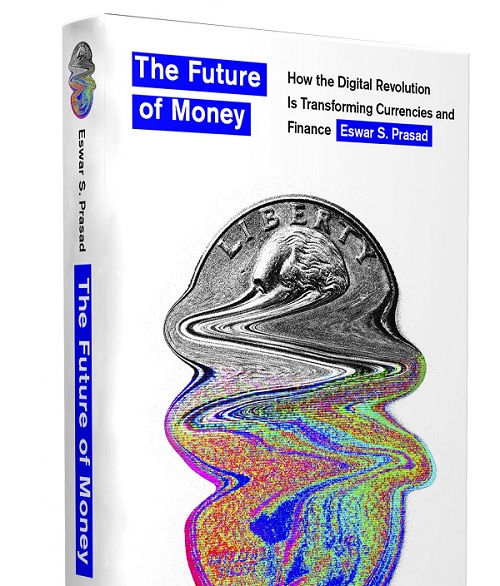
How the Digital Revolution Is Transforming Currencies and Finance
ART | ESWAR S. PRASAD | Are cryptocurrencies the next big investment, a fad, or a currency that will transform the economic and financial landscape? What are some of the advantages and shortcomings of digital currencies? Who will benefit from these new currencies?
Eswar S. Prasad attempts to address these questions in `The Future of Money: How the Digital Revolution Is Transforming Currencies and Finance’. Prasad, the Tolani Senior Professor of Trade Policy at Cornell University and the author of several books on currencies, provides an interesting and insightful exposition on the shifting landscape from traditional paper notes to digital currencies.
Prasad begins his discussion of the future of money with a quote from Cecilia Skingsley, the deputy governor of Sweden’s central bank: “If you extrapolate current trends, the last note will have been handed back to the Riksbank by 2030.” Skingsley is not the only government official who sees a grand future for digital currencies. China is another country that has been moving away from paper currency. In the United States, President Biden, recognising the importance of new digital assets, signed an executive order to ensure digital assets’ responsible development in March 2022.
The book is divided into four parts. Part I, “Laying the Bedrock,” looks at the future and promise of digital currencies and provides an introduction to finance for those with little background. Part II, “Innovations,” focuses on the history of fintech and the crypto revolution. Part III, “Central Bank Money” makes a case for central bank digital currencies (CBDCs). Part IV, “Ramifications,” considers the potential consequences for the international monetary system.
The “Innovations” section of the book begins with a chapter titled “Will Fintech Make the World a Better Place?” Here, the author takes us through the history of fintech, which he points out is a catchall term for novel financial technologies. It was first coined in 1993 with Citicorp’s creation of the Financial Services Technology Consortium. However, some innovations, such the ATM, have become so ubiquitous that we forget these were once novel technologies. The history includes an interesting look at newer innovations, such as M-PESA, which allowed individuals in Kenya to conduct banking through a mobile phone, as well as peer-to-peer lending, crowdfunding, and on-demand insurance. Many of these new services will pose challenges to traditional financial services companies.
Today, fintech is most closely associated with cryptocurrencies, such as bitcoin and Ethereum. However, a discussion of cryptocurrencies cannot begin without understanding the blockchain and how this technology is transforming business and finance. Blockchain technology has been touted as the future of finance and of numerous other areas of business, including securing of medical records, non-fungible token (NFT) marketplaces, and supply chain and logistics monitoring.
Most investment professionals will be aware of the blockchain and the concept of a decentralised ledger across a peer-to-peer network, but many may not understand the technology thoroughly. Prasad provides a detailed but accessible explanation of how the blockchain works, from its historical origins to the technology underlying the system. The term “blockchain” is associated with a variety of cryptocurrencies. However, the protocols used to validate transactions differ for various blockchains. Furthermore, each protocol has advantages and weaknesses. Will many alternative protocols continue, or will one emerge as the standard for the industry?
Bitcoin uses a “proof-of-work” protocol to validate transactions, which requires block creators, known as miners, to solve a randomly generated cryptographic problem. The approach allows transactions to be validated without a trusted third party. However, this method requires significant computing resources, which need large amounts of electricity to power the computers. Another downside of this approach is that it allows only a relatively small number of transactions to be validated simultaneously.
Ethereum uses a “proof-of-stake” protocol. Proof of stake was created to deal with some of the inefficiencies of the proof-of-work approach. Here, the privilege of validating a block is based on how much has been “staked” by competing nodes. However, as Prasad points out, this less resource-intensive approach is not without its shortcomings.
Prasad debunks some of the myths of crypto and other digital currencies. For example, many view using cryptocurrencies, such as bitcoin, as a way to maintain anonymity. The reality is that, unlike cash, digital currencies require identifiers for consumers to receive the goods purchased with digital currencies, which removes the anonymity. Blockchain has also been viewed as a secure technology. Although this technology offers greater security than other methods, Prasad points out ways that individuals can hack the various protocols.
Like all new technologies, the fintech revolution has brought with it a whole new language to define the new offerings. `The Future of Money’ allows investors to learn the new vernacular of this field and consider which innovations may offer the greatest investable opportunities.
Innovations produce winners and losers by creating new opportunities and challenges for incumbents. Financial industry innovations are no different. Understanding some of the current and potential future changes will enable analysts to better determine which businesses and industries are likely to prosper and which are likely to suffer. The Future of Money provides readers with a window into some of the opportunities and challenges that lie ahead for the financial sector.
 The Independent Uganda: You get the Truth we Pay the Price
The Independent Uganda: You get the Truth we Pay the Price



